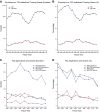NIH research funding and early career physician scientists: continuing challenges in the 21st century
- PMID: 24297696
- PMCID: PMC3929670
- DOI: 10.1096/fj.13-241687
NIH research funding and early career physician scientists: continuing challenges in the 21st century
Abstract
Physician scientists (researchers with either M.D. or M.D.-Ph.D. degrees) have the unique potential to combine clinical perspectives with scientific insight, and their participation in biomedical research has long been an important topic for policymakers and educators. Given the recent changes in the research environment, an update and extension of earlier studies of this population was needed. Our findings show that physician scientists are less likely to take a major role in biomedical research than they were in the past. The number of physician scientists receiving postdoctoral research training and career development awards is at an all-time low. Physician scientists today, on average, receive their first major research award (R01 equivalent) at a later age than in the 1980s. The number of first-time R01-equivalent awards to physicians is at the same level as it was 30 yr ago, but physicians now represent a smaller percentage of the grant recipients. The long-term decline in the number of physicians entering research careers was temporarily halted during the period of substantial U.S. National Institutes of Health (NIH) budget growth (1998-2003). These gains are lost, however, in the subsequent years when NIH budgets failed to keep pace with rising costs.
Keywords: science policy; training; workforce.
Figures






References
-
- Their S., Challoner D. R., Cockerham J., Johns T., Mann M., Skinner D., Weldond V., Whybrow P., Young F., Sherman J., Plumb D., Bickel J., Morgan T. (1980) Proposals addressing the decline in the training of physician investigators: report of the ad hoc committee of the AAMC. Clin. Res. 28, 85–93
-
- Rockey S. (2013) Does your academic training destine your choice of research subject? Rock Talk blog, February 1, http://nexus.od.nih.gov/all/2013/02/01/does-your-academic-training-desti...
-
- Schafer A. I. (2009). The history of physican as scientist. In The Vanishing Physician-Scientist (Schafer A. I., ed) pp. 17–38, Cornell University Press, Ithaca, NY, USA
-
- Wyngaarden J. B. (1979) The clinical investigator as an endangered species. N. Engl. J. Med. 301, 1254–1259 - PubMed
-
- Gill G. N. (1984) The end of the physician-scientist? Am. Scholar, 53, 353–368
Publication types
MeSH terms
LinkOut - more resources
Full Text Sources
Other Literature Sources
Miscellaneous

